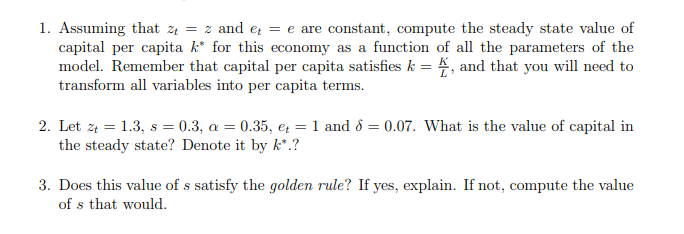1. Assuming that z4 = z and e = e are constant, compute the steady state value of capital per capita k* for this economy as a function of all the parameters of the model. Remember that capital per capita satisfies k = 4, and that you will need to transform all variables into per capita terms.
1. Assuming that z4 = z and e = e are constant, compute the steady state value of capital per capita k* for this economy as a function of all the parameters of the model. Remember that capital per capita satisfies k = 4, and that you will need to transform all variables into per capita terms.
Chapter1: Making Economics Decisions
Section: Chapter Questions
Problem 1QTC
Related questions
Question
i need Question 1 solution

Transcribed Image Text:1. Assuming that z4 = z and e = e are constant, compute the steady state value of
capital per capita k* for this economy as a function of all the parameters of the
model. Remember that capital per capita satisfies k = 4, and that you will need to
transform all variables into per capita terms.
2. Let z4 = 1.3, s = 0.3, a = 0.35, e = 1 and ô = 0.07. What is the value of capital in
the steady state? Denote it by k*.?
3. Does this value of s satisfy the golden rule? If yes, explain. If not, compute the value
of s that would.
![Solow Model
Consider a Solow growth model like the one discussed in class, but incorporating the
possibility of less than full employment. Let t denote a period. The production function is
Y; = zK; [e,L]*¬,
so that given the current TFP z4, the capital input K, and the labor input N = eL, firms
produce output Y; in period t. Here e € [0, 1] denotes the proportion of the labor force L
that is employed at each point in time. If e = 1 the economy is at full employment, with
e = 0, on the other hand, everyone is unemployed. Total resources satisfy
Y; = C; + I,
where C; denotes aggregate consumption, I aggregate investment, and Y; is GDP. Assume
that people invest a constant proportion s of their income, so that aggregate investment
satisfies
It = sY;
and capital evolves according to
K+1 = K,(1 – 8) + I,
%3D
where ổ denotes depreciation. This function tells us how capital next period is related to
current capital, investment, and depreciation. In the book, you have seen the expression
written as
AK = I – 8K,
note that the two are equivalent.](/v2/_next/image?url=https%3A%2F%2Fcontent.bartleby.com%2Fqna-images%2Fquestion%2F992c8c15-027c-4c4f-9afa-4b2b8b2073f2%2Fac0a7cc7-ef34-4026-a841-210f3b3876de%2F2r1hfnf_processed.png&w=3840&q=75)
Transcribed Image Text:Solow Model
Consider a Solow growth model like the one discussed in class, but incorporating the
possibility of less than full employment. Let t denote a period. The production function is
Y; = zK; [e,L]*¬,
so that given the current TFP z4, the capital input K, and the labor input N = eL, firms
produce output Y; in period t. Here e € [0, 1] denotes the proportion of the labor force L
that is employed at each point in time. If e = 1 the economy is at full employment, with
e = 0, on the other hand, everyone is unemployed. Total resources satisfy
Y; = C; + I,
where C; denotes aggregate consumption, I aggregate investment, and Y; is GDP. Assume
that people invest a constant proportion s of their income, so that aggregate investment
satisfies
It = sY;
and capital evolves according to
K+1 = K,(1 – 8) + I,
%3D
where ổ denotes depreciation. This function tells us how capital next period is related to
current capital, investment, and depreciation. In the book, you have seen the expression
written as
AK = I – 8K,
note that the two are equivalent.
Expert Solution
This question has been solved!
Explore an expertly crafted, step-by-step solution for a thorough understanding of key concepts.
Step by step
Solved in 2 steps

Knowledge Booster
Learn more about
Need a deep-dive on the concept behind this application? Look no further. Learn more about this topic, economics and related others by exploring similar questions and additional content below.Recommended textbooks for you


Principles of Economics (12th Edition)
Economics
ISBN:
9780134078779
Author:
Karl E. Case, Ray C. Fair, Sharon E. Oster
Publisher:
PEARSON

Engineering Economy (17th Edition)
Economics
ISBN:
9780134870069
Author:
William G. Sullivan, Elin M. Wicks, C. Patrick Koelling
Publisher:
PEARSON


Principles of Economics (12th Edition)
Economics
ISBN:
9780134078779
Author:
Karl E. Case, Ray C. Fair, Sharon E. Oster
Publisher:
PEARSON

Engineering Economy (17th Edition)
Economics
ISBN:
9780134870069
Author:
William G. Sullivan, Elin M. Wicks, C. Patrick Koelling
Publisher:
PEARSON

Principles of Economics (MindTap Course List)
Economics
ISBN:
9781305585126
Author:
N. Gregory Mankiw
Publisher:
Cengage Learning

Managerial Economics: A Problem Solving Approach
Economics
ISBN:
9781337106665
Author:
Luke M. Froeb, Brian T. McCann, Michael R. Ward, Mike Shor
Publisher:
Cengage Learning

Managerial Economics & Business Strategy (Mcgraw-…
Economics
ISBN:
9781259290619
Author:
Michael Baye, Jeff Prince
Publisher:
McGraw-Hill Education